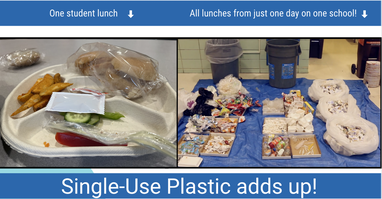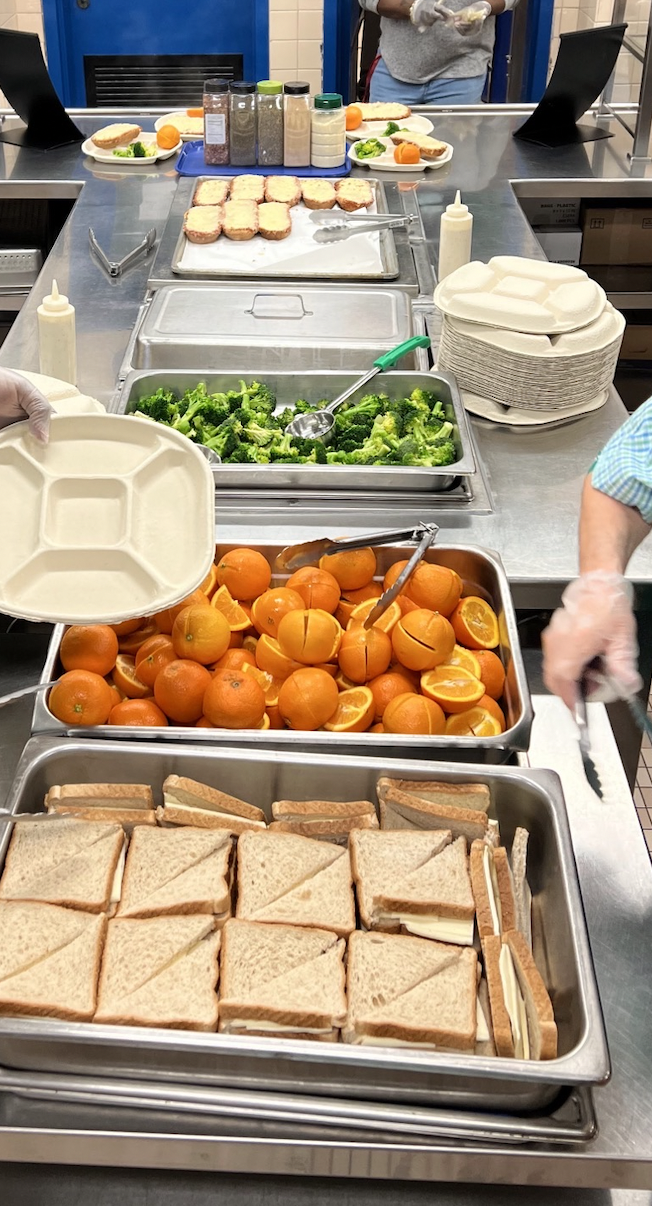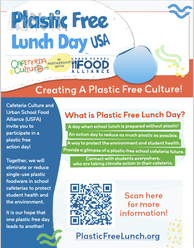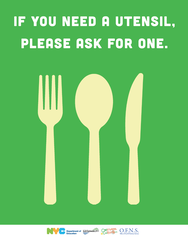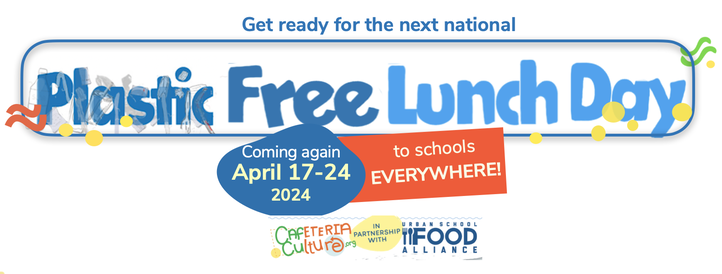For School Food Service
Directors, Managers, and Teams
Join us April 17-24, 2024
or any day!
Schools everywhere are invited.
|
Join Urban School Food Alliance districts, New York City, Chicago, and hundreds of schools across the US for Plastic Free Lunch Day USA April 17-24 or any day! Is your school/school district on board? Choose one easy action for this spring and start planning for a fall Plastic Free Lunch Day |
Easy Implementations for one day & every day:
Or run a small pilot, Plastic Free Lunch Day or Plastic Reduction Day, in just a few schools any time this spring. |
Menu Ideas & Preparation Video below ⬇︎
ABOUT
WHY?
|
US Schools serve 7.35 billion meals annually. These meals are packed with non-biodegradable single-use plastics (SUPs) that make a significant contribution to the US plastic waste stream and the staggering global plastic pollution problem. Most of these SUPs end up in a landfill or environment. Plastic Free Lunch Day (PFLD) USA provides an opportunity for students to learn about plastic pollution and for students and school food staff to take meaningful plastic-reduction action. |
One plastic free day leads to another!
Join us in creating a vision for an equitable and sustainable future.
Join us in creating a vision for an equitable and sustainable future.
RESOURCE CHECKLIST
Promotion and Communication
Help us document this national day of action:
- School Leadership Email Template
- PFLD overview (what? why? QR code, free movie sign up).
- Social Media Kit - (copy suggested posts)
- Social Media graphics - ready to go templates (in Google folder; add your logo/ date options)
Help us document this national day of action:
- Photo and Video; tips sheet and shot examples -> & share with us to help build momentum for the next PFLD!
- USFA Member PFLD Press Release Template (copy, adapt and add your logo)
- All District PFLD Press Release Template (copy, adapt and add your logo)
- PFLD Spanish promo flyer - (add your logo!)
- PFLD Promotion Tip Sheet
- Morning Announcements -Template (for 5 days leading up to PFLD)
- Letter Template to Families everywhere (copy and adapt)
- **new - Letter Template SPANISH to Families everywhere (copiar y adaptar)
- NYC Letter template to Families for monthly Plastic Free Lunch Days, starting Nov 2, 2022! (copy and adapt)
- **new - NYC Letter SPANISH template to Families for monthly Plastic Free Lunch Days (copiar y adaptar)
- Sample Menu for Plastic Free Lunch Day (see photos below)
Movie/ Video inspiration for students, teachers, staff and families!
- Free Movie Screening! Create school-wide engagement for Plastic Free Lunch Day with a free screening of Microplastic Madness, Cafeteria Culture's student-led, award winning movie. After an in-depth investigation of plastic pollution in their community, 5th grade students look at their own plastic use in the cafeteira and lead the first Plastic Free Lunch Day. This is an uplifting and informative movie, guaranteed to spark a lively classroom discussion and inspire action!
- Plastic Free Lunch Day USA promo video (3 mins)- share on cafeteria and school screens and in the classroom as part of morning announcements
- Menu Preparation & Tips for Kitchen Staff video below
Issue Briefs
- Cost Savings from Plastic-Reducing Food Service Adaptations
- Covid & Plastic Foodware: Why Grab and Go Food Dispensing Methods do not Prevent COVID-19 Transmission
- PLASTIC IS A HAZARDOUS MATERIAL: How plastic is making us fat & sick
- Reusable Dishware: Calculate Cost Savings
MENU IDEAS
Snapshot
🌮 a handheld food day -> no plastic utensils!
+ 🥒 sliced veggies + dip Salad Bar
💚 a no-condiment packet day -> serve in bottles
🌮 a handheld food day -> no plastic utensils!
+ 🥒 sliced veggies + dip Salad Bar
💚 a no-condiment packet day -> serve in bottles
|
San Diego Unified School District will eliminate as much single-use plastic with no sporks
• Dipper bar at all salad bars districtwide will include- celery sticks, carrot sticks, grape tomatoes, cucumber slices and broccoli florets. Dipping sauces to include Ranch and Italian dressing, homemade salsas and dressings encouraged. Fresh fruit to include seasonal cut fruit and HOTM, no canned fruit will be served on this day. • Veggie burger will be offered in place of prepackaged salads at secondary sites. |
|
The NYC Plastic Free Lunch Day menu served on May 16, 2022 was all handheld food: pizza, accompanied by a crudité style Salad Bar, and fresh fruit; no utensils needed (see the Menu Preparation video below).
Other ideas for a plastic free, handheld menu include: - mozzarella sticks - tacos, burritos - egg rolls - burgers Additionally: - no condiment packets; dipping sauce and dressing is in squeeze bottles or served directly onto the plate. - sandwiches served without being individually wrapped in plastic film (prepared and served bulk style in trays with aluminum foil covers0; and - utensils given "by request only" - water cups are also “by request only.” |
|
PREPARATION TIPS VIDEO
Training video for kitchen staff - created fo4 May 16th, 2022 NYC PFLD
Plastic Free Lunch Day - Menu Preparation & Tips for Kitchen Staff
Created by CafeteriaCulture.org in partnership with NYC Department of Education Office of Food and Nutrition Services and Office of Sustainability. This video shows you how to prepare the PLASTIC FREE LUNCH DAY MENU that was served to over 750 elementary schools on Monday May 16th, 2022.
Plastic Free Lunch Day - Menu Preparation & Tips for Kitchen Staff
Created by CafeteriaCulture.org in partnership with NYC Department of Education Office of Food and Nutrition Services and Office of Sustainability. This video shows you how to prepare the PLASTIC FREE LUNCH DAY MENU that was served to over 750 elementary schools on Monday May 16th, 2022.
Flyers
Print these or create your own!
|
For secondary schools.
Space to add your own logo and date Download PDF -> |
Add the date & your own logo.
Download PDF |
|
|
For elementary schools.
Download PDF -> |
For elementary schools, cups and utensils. Download the 2-page PDF ->
|
For all schools. Download PDF >
|
|
Download PFLD overview November 8, 2023 ->
|
Download PFLD overview English Nov 8, 2023 ->
|
Single-use Plastic Pollution Problem
in a snapshot
Why DO we need #plasticfreelunch?
The world is awash in toxic and polluting single-use plastics made from hazardous chemicals and climate-damaging fossil fuels.
380 million metric tons of plastic are produced each year.
The US plastic recycling rate has dropped below 6%!
US Schools serve 7.35 billion meals annually. Those meals are packed with non-biodegradable Single-use plastics (SUPs) that make a significant contribution to the US plastic waste stream and the staggering global plastic pollution problem. Most of those SUPs end up in a landfill or environment.
Plastic Free Lunch Day provides students an opportunity to learn about plastic pollution and take meaningful plastic-reduction action. One plastic free day leads to another and creates a vision and actionable ideas to move forward equitably and sustainably.
380 million metric tons of plastic are produced each year.
The US plastic recycling rate has dropped below 6%!
US Schools serve 7.35 billion meals annually. Those meals are packed with non-biodegradable Single-use plastics (SUPs) that make a significant contribution to the US plastic waste stream and the staggering global plastic pollution problem. Most of those SUPs end up in a landfill or environment.
Plastic Free Lunch Day provides students an opportunity to learn about plastic pollution and take meaningful plastic-reduction action. One plastic free day leads to another and creates a vision and actionable ideas to move forward equitably and sustainably.
1o reasons to take plastic free, climate action
- Making & disposing of plastic is fueling the climate crisis.
- Plastics are made from fossil fuels.
- Plastics are the 5th largest contributor of greenhouse gas emissions.
- Less than 6% of plastic is recycled in the US.
- Plastic kills 100,000 marine animals every year.
- The US creates more plastic waste than any other nation.
- Plastic never goes away. It degrades into tiny microplastics.
- Scientists have found microplastics in the deepest parts of the ocean, and in our soil, food, water and air.
- Recent studies have also found microplastics in our bodies: our gut, our tissues, our poop, our blood, the deepest parts of our lungs!
- We are all eating and breathing microplastics.
What is a Single-Use Plastic and Why is it a Problem?
Each year, we produce over 350 million metric tons of plastic; more than 40% of this is single-use plastic--plastic packaging and foodware that is used for less than 20 minutes. Because plastic is not recyclable, most discarded plastic is sent to landfills or "leaks" into the natural environment.
Plastic does not biodegrade. Instead it breaks or fragments into small particles called microplastics and then into smaller particles called nanoplastics. Because plastic is made from fossil fuels and thousands of persistent toxic chemicals, they transfer thousands of migrating chemicals into our food during use. After disposal and fragmentation, plastic particles carry and distribute these toxic chemicals to every inch of the globe.
Scientists have found micro and nanoplastics in our digestive tract, deep in our lung tissue, in the placenta, and circulating in our blood. Nanoplastics deliver thousands of toxic chemicals directly to the organs, tissues, and cells in our bodies. We now face the public health crisis of our time.
School cafeterias serve over 40 million meals a day and make a large contribution to the plastic waste stream. School cafeterias are a great place to begin reducing single-use plastics, while also protecting the health of our students--society's most vulnerable members. Plastic free lunch day is a first step that results in useful photos and data but, most importantly, it shows everyone that food-dispensing and eating does not require plastic!
Plastic does not biodegrade. Instead it breaks or fragments into small particles called microplastics and then into smaller particles called nanoplastics. Because plastic is made from fossil fuels and thousands of persistent toxic chemicals, they transfer thousands of migrating chemicals into our food during use. After disposal and fragmentation, plastic particles carry and distribute these toxic chemicals to every inch of the globe.
Scientists have found micro and nanoplastics in our digestive tract, deep in our lung tissue, in the placenta, and circulating in our blood. Nanoplastics deliver thousands of toxic chemicals directly to the organs, tissues, and cells in our bodies. We now face the public health crisis of our time.
School cafeterias serve over 40 million meals a day and make a large contribution to the plastic waste stream. School cafeterias are a great place to begin reducing single-use plastics, while also protecting the health of our students--society's most vulnerable members. Plastic free lunch day is a first step that results in useful photos and data but, most importantly, it shows everyone that food-dispensing and eating does not require plastic!



